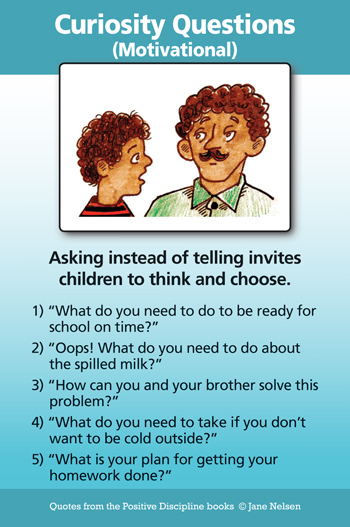by Dr. Jane Nelsen
Helping children explore the consequences of their choices is much different from imposing consequences on them. Exploring invites the participation of children to think for themselves and figure out the consequences of their choice, to decide what is important to them, and how to achieve what they want. The end result is focusing on solutions to the problem instead of focusing on consequences.
Imposing consequences often invites rebellion and defensive thinking instead of explorative thinking. The key to helping children explore is to stop telling and to start asking curiosity questions.
Too often adults tell children what happened, what caused it to happen, how the child should feel about it, what the child should learn from it, and what the child should do about it. It is much more respectful and encouraging when we ask what happened, what the child thinks caused it, how the child feels about it, what the child has learned, what ideas the child has to solve the problem, or how the child can use what she has learned in the future. This is the true meaning of education, which comes from the Latin word educare’, which means to draw forth. Too often adults try to stuff in instead of draw forth, and then wonder why children don’t learn.
Typical curiosity questions:
- What were you trying to accomplish?
- How do you feel about what happened?
- What did you learn from this?
- How can you use what you learned in the future?
- What ideas do you have for solutions now?
I call these typical curiosity questions because it is important not to have a script. The point is to get into the child’s world. You’ll notice that “Why?” isn’t one of the suggested questions. The reason is that “Why?” usually sounds accusatory and invites defensiveness. This isn’t always the case. All of the questions can be asked in an accusatory tone of voice. “Why?” works when children feel that you are truly interested in their point of view.
The following guidelines will help when using curiosity questions:
- Don’t have an agenda. You aren’t getting into the child’s world if you have an agenda about how the child should answer these questions. That is why they are called curiosity questions.
- Don’t ask questions if either of you are upset. Wait until you are both feeling calm.
- Ask curiosity questions from your heart. Use your wisdom to show you how to get into the child’s world and show empathy and acceptance.
When the solutions come from the children, or are brainstormed together and the child chooses what will be most helpful, they learn that they can make a valuable contribution when using respectful decision-making skills. Children learn that mistakes aren’t horrible if you don’t beat yourself up about them and if you look at mistakes as opportunities to learn.


No Comments yet!